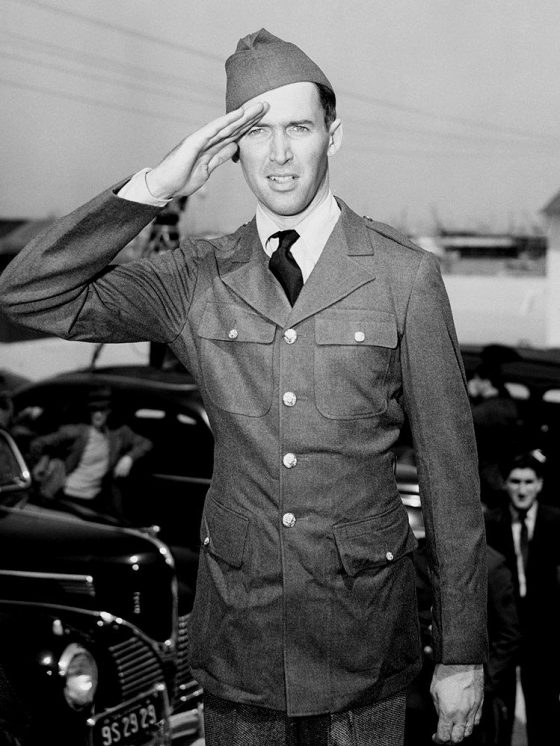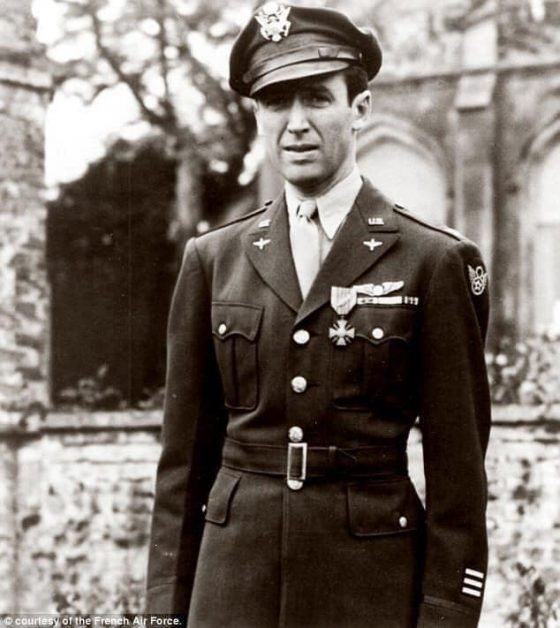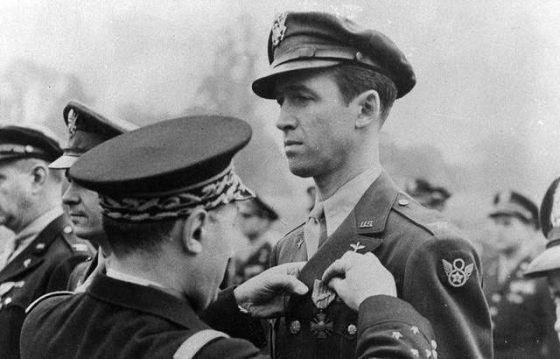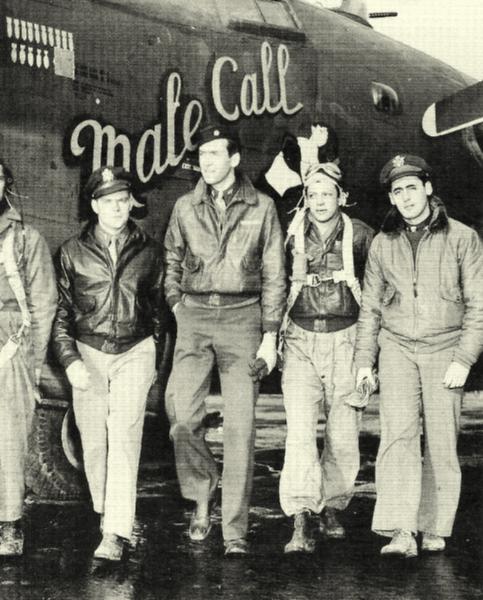James Stewart was the first film star to enter the service for World War II, joining a year before Pearl Harbour was bombed.

He was initially refused entry into the Air Force because he weighed 5 pounds less than the required 148 pounds, but he talked the recruitment officer into ignoring the test. He eventually became a Colonel (active duty) and then Brigadier General in the United States Air Force Reserve, and earned the Air Medal, the Distinguished Flying Cross, the Croix de Guerre and 7 battle stars. In 1959, he served in the Air Force Reserve, before retiring as a brigadier general. (Walter Matthau was a sergeant in his unit).Despite having been a decorated war hero in World War II, he declined to talk about this, in part because of the traumatic experiences he had in killing others and watching friends die.

After the War James Stewart tended to steer clear of those Hollywood war films, explaining that they were hardly ever accurate. During his career, he only starred in two war films quite a a while after the War ended – “Strategic Air Command” (1955) and “The Mountain Road” (1960).

Col. Ramsey Potts (above, left in photo) presents the
Distinguished Flying Cross to Maj. James Stewart for
extraordinary achievement while serving as deputy leader
of a combat wing on a bombing mission to Brunswick,
Germany, Feb. 20, 1944.
James Stewart was interested in aviation as a child, he had taken his first flight while still in Indiana from one of the
barnstorming pilots that used to travel the Midwest. As a successful actor in 1935 Jimmy was
able to afford flying lessons. He received his civilian pilot’s license in 1935, and bought his first
airplane. In 1938 he obtained his commercial pilot’s licence. He often flew cross country to
visit his parents in Pennsylvania, navigating by the railroad tracks.
In the military, he was to make extensive use of his civilian pilot’s training. In March 1941 at age
32, he reported for duty as Private James Stewart at Fort McArthur and was assigned to the
Army Air Corps at Moffett Field. To comply with the regulations of the Air Corps proficiency
board, Stewart required additional 100 flying hours and bought them at a nearby field, at his
own expense. He then took and passed a very stiff proficiency board examination.
In January 1942 Stewart was commissioned a 2nd Lieutenant. He was then sent to Mather
Field in California as a four engine instructor, this included both the B-17 and B-24 heavy
bombers. Much to his dismay, Stewart stayed stateside for almost two years working as a flight
instructor, until commanding officers finally yielded to his request to be sent overseas.
In November 1943, now a Captain and Operations Officer for the 703rd Bomb Squadron, 445th
Bombardment Group of the Eighth Air Force, he arrived in Tibenham, in Norfolk, England. In March of
1944 he was transferred to the 453rd Bombardment Group at Old Buckenham (Old Buc) quite near to Tibenham
Throughout his combat career, James Stewart flew as lead pilot in B-24 Liberators.
Stewart’s war record included 20 combat missions as command pilot over enemy territory,
including raids deep into Germany to Berlin. He didn’t fly the milk runs, and his missions
included bombing raids to Berlin, Brunswick, Bremen, Frankfurt, and Schweinfurt. His most
memorable mission, Stewart served as the flight leader of a 1000 plain raid to Berlin. He was
awarded the Distinguished Flying Cross with two Oak Leaf Clusters, the Air Medal with three
Oak Leaf Clusters, and the French Croix de Guerre with Palm.
By the end of the war he had risen to the rank of Colonel. After the war he remained with the
US Air Force Reserves and was eventually promoted to Brigadier General in 1959. In 1966, he
participated in a bombing strike in Vietnam, as an observer on a B-52 bomber. He retired from
the Air Force in 1968 and received the Distinguished Service Medal and ultimately, the
Presidential Medal of Freedom.
James Stewart returned to Tibenham in Norfolk in the summer of 1975 – this is a recollection written by someone who was there at the time :-







James Stewart’s visit to Tibenham in 1975:
“…….In early June, 1975, I took a phone call from a [Tibenham] gliding club member who told me that film star James Stewart was planning a private visit to the base – a members’ only job, apparently; very hush-hush; no fans; no Press! But if I didn’t let on how I knew, kept in the background, and didn’t wave a notebook about, then I might be able to pass muster as a club member.James Stewart.
Believed to be on the Control Tower of the old US airbase at Tibenham, Norfolk. Image: Courtesy of the 2nd Air Division Memorial Library Collection and EDP.
However, James Stewart’s visit was not a total surprise because during the Second World War he had been based at Tibenham (and elsewhere), from where he flew 20 bomber missions. He was a genuine war hero, and now, thirty years and many films later, he was appearing in the stage play ‘Harvey’ in London, and was simply taking advantage of a day off. Though it was not known at the time, he had also planned to do a photoshoot with Terry Fincher for the Daily Express.

On the day in question I did my best to melt into the background and became a quiet bystander as James toured the base and the ruined control tower, and gazed at the runway. He clearly found it all very affecting. When they offered him a towed glider flight to RAF Coltishall and back, he jumped at the chance, and happily squeezed his lanky frame into the tiny cockpit. While he was away ….. I withdrew for a pub lunch.
Back at Tibenham again, Mr Stewart was ushered into the clubroom for sandwiches and coffee, where he looked at more memorabilia and chatted freely with everyone. Every so often his gentle drawl, ‘ahhh, well,’ and ‘kinda’ and ‘sorta’ could be heard across the crowded room. Relaxed and affable, he was in his element.

I was sitting in a corner munching sandwiches when James Stewart’s agent came across. ‘He knows who you are,’ he said. ‘He knows you’re a local journalist.’ I envisaged a firing squad. ‘Would you like to meet him?’ Yes, please!
Then James Stewart came across and sat down beside me, balancing a cup and saucer on his knee, and we talked for ten minutes. Deliberately, I ignored my notebook and later on had to struggle to remember some of the quotes. But in a way I was glad. It was not an interview, it was a neighbourly chat, freely offered and entered into.James Stewart at the derelict U.S. air base at Tibenham in June 1975. In the background, the former Control Tower where it is believed the above image of him, sitting on its rail during the war, was taken. Photo: © As on the above image.
James Stewart was like that. Aimable, interested, and at ease. He talked about Tibenham and how tough he had found it to remember his way around the base. ‘The only thing I can really orientate on is the control tower,’ he said. He talked about his glider flight, and I asked if he had taken the controls. ‘Sure I flew it. Sure I did.’ And then he talked about Norfolk and Norwich and how he hoped one day to visit the city’s American Memorial Library. Then his agent came back, and Stewart rose, shook hands, and wandered back towards the sandwiches.James Stewart being prepared for his glider flight to Coltishall and back in 1975 –‘”Sure I flew it. Sure I did.”
James Stewart visits Norwich and the Norwood Rooms:
“Having revisited his War-time Norfolk air base at Tibenham in 1975, Hollywood film star James Stewart kept his word and joined in with two or three of the subsequent 2nd Air Division reunions. But he did not come back to England as a visiting ‘celeb,’ but as an ordinary ex-flyer, one of the boys. He stayed with his mates in the same hotels, travelled with them by coach as they did the rounds of once-familiar locations, and remained as anonymous as possible within the group. They all liked him for that.The former Norwich Central Library in which the American Memorial Library was located.
One of his more formal appearances was on the day he and his group went to see the former American Memorial Library – later severely damaged by fire, and replaced by a new Memorial tribute in the Forum – which at the time was housed at the old City library. Here he did pose for photographs, and behaved as a visiting dignitary would in a public role.
I have no doubt, however, that he had his ‘anonymous’ role firmly in mind when he and his colleagues, on another of their four-yearly visits, went to the former Norwood Rooms in Aylsham Road, Norwich – a popular dancing and dining venue at the time – for a veterans’ banquet. My wife and I were also invited, and we saw what happened.The former Norwood Rooms, Norwich in which James Stewart made an appearance.
First, he did not sit with the brass and bigwigs on the top table. He stayed at his table on the floor of the hall surrounded by his pals. And second, he was a very reluctant speaker.
When he was finally persuaded to clamber on to the band platform to say a few words, he thanked everyone, including the people of Norfolk, for the welcome they gave the Americans during the War, and he told the story of the powdered eggs. Apparently powdered eggs were the staple breakfast diet in the officers’ mess at Tibenham, and Stewart became heartily sick of them. On other days, however, they were fed fresh farm eggs straight from a local farm. Unfortunately, those were the days on which a bombing mission was scheduled. So that was how they knew what was happening. Dried eggs, and they had their feet on the ground a little longer. Fresh eggs, and it was bombs away!

Later the same evening there occurred one of those rare, unrehearsed and unexpected events that invariably stick in the memory. The band was playing some Glenn Miller favourites, which got the veterans whistling and cheering. It was particularly apt because the film, The Glenn Miller Story, starring James Stewart as Miller, was still doing the rounds. The band leader beckoned to James Stewart and invited him to take over the conducting role. Stewart shook his head. Then the audience started clapping and shouting, and he reluctantly clambered back on to the stage and led the band through an admittedly slowish version of Moonlight Serenade. It brought the house down.

Some years’ later, our local morning newspaper began a scheme promoting plaques to be fixed to buildings where famous people had appeared. Most of those erected, it seemed to me, related to 1960s and 1970s pop groups. There was nothing to remind passers-by, for example, that Count Basie and his band once appeared at the old Samson & Hercules dance hall in Tombland, Norwich.
Or that at the old Norwood Rooms a famous Hollywood film star once clambered on to the stage, borrowed the resident band, and reprised a tiny piece of one of his best-known film roles.

Place your comment